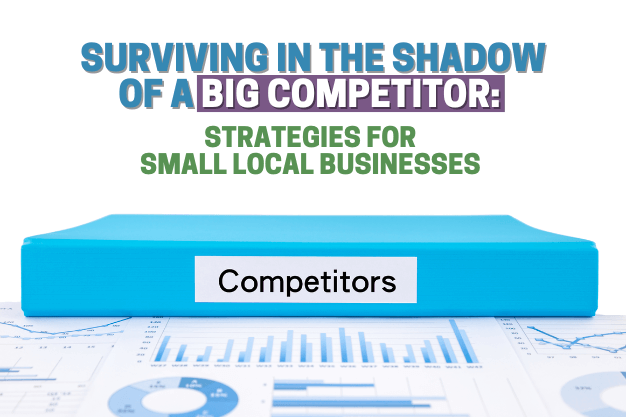Running a local business is no easy feat, and the challenge only intensifies when a big competitor moves into your neighborhood. Whether it’s a national chain restaurant, a large retail store, or a franchise operation with deep pockets, the presence of a giant in your industry can feel intimidating. But here’s the good news: as a small business, you have unique advantages that big companies can’t replicate. This article will explore practical, advanced strategies for thriving—even when you’re competing against much larger entities.
1. Leverage Your Local Roots:
Big chains might have brand recognition, but they often lack the personal touch that small businesses excel at. As a local business, you’re part of the community, and that connection can be your greatest strength.
Example: Picture a mom-and-pop pizza place going head-to-head with a popular pizza chain. Instead of trying to compete on price, the local pizzeria leans into its community ties. They host “Pizza and Paint” nights where local artists teach classes while customers enjoy homemade pizza. They collaborate with nearby farmers to create seasonal pizzas featuring fresh, local ingredients, and promote these collaborations on social media. By organizing charity events where a portion of each pizza sold goes to a local cause, they become not just a place to eat, but a beloved part of the community’s social fabric. The big chain might offer consistency, but your pizzeria offers heart—and that’s something customers will rally around.
2. Offer Personalized Customer Experiences:
One-size-fits-all may work for big businesses, but small businesses can thrive by offering personalized service that makes customers feel valued and understood.
Example: Imagine a local jeweler facing competition from a national chain. Rather than trying to match the chain’s vast inventory, the jeweler focuses on personalization. They offer custom jewelry design services where customers can create a piece that tells their unique story—whether it’s an engagement ring crafted to symbolize the couple’s journey together or a pendant made with a birthstone that holds special significance. The jeweler also remembers customers’ special dates and sends personalized offers or even a small, thoughtful gift. They host exclusive “Design Your Own Jewelry” workshops where customers can learn about gemstones and metals while sketching their dream piece. By making each customer interaction deeply personal, the jeweler creates an experience that’s as unique as the jewelry they sell—something the big chain simply can’t replicate.
3. Focus on Quality Over Quantity:
While large competitors may compete on price or volume, you can differentiate your business by focusing on quality. Whether it’s superior products, exceptional service, or a more enjoyable customer experience, quality can be your differentiator.
Example: Think of a local bowling alley up against a slick, new national franchise. Instead of trying to outdo the franchise on amenities, the bowling alley focuses on quality and community. They invest in high-end lane maintenance and provide top-notch customer service where staff know regulars by name. They host “Classic Bowling Night” where players use vintage-style balls and pins, creating a nostalgic experience. The alley partners with a local brewery to offer craft beer tastings during league nights, and they feature local food vendors instead of typical concession stand fare. By curating a top-quality, authentic experience, the bowling alley becomes a beloved local hangout that people choose for its superior service and unique atmosphere—something the franchise can’t easily match.
4. Utilize Local SEO to Dominate Search Rankings:
Big businesses often have large marketing budgets, but that doesn’t mean they’ll always win online. Local SEO is your secret weapon for attracting customers searching for services in your area.
Example: Imagine a local hardware store competing with a big-box retailer. The store leverages local SEO to ensure it dominates online searches for “best hardware store near me” or “gardening supplies in [Your Town].” They regularly update their Google Business Profile with photos of new products, customer testimonials, and posts about upcoming workshops on DIY home projects. They also optimize their website with local keywords, and publish blog posts featuring expert advice on seasonal home improvement tasks specific to the area, like “Preparing Your Home for Winter in [Your Town].” By focusing on what makes their location unique, they ensure that when locals search for anything hardware-related, their business is the first one that pops up, driving foot traffic and online orders that the big-box store might overlook.

5. Capitalize on Flexibility and Agility:
One of the most significant advantages of being a small business is your ability to adapt quickly. While large corporations may take months to implement changes, you can pivot your business model, introduce new products, or change your marketing strategy almost instantly.
Example: Consider a local café up against a major coffee chain. The café capitalizes on its agility by quickly introducing new seasonal menu items, often inspired by customer suggestions. They might launch a “Customer Creation Contest,” where patrons submit ideas for new drinks, and the winner sees their creation on the menu for a month. When local trends shift—like a sudden interest in plant-based diets—they’re quick to introduce vegan options, sourcing ingredients from local farms. They might even pivot their business model temporarily to cater to an influx of tourists during a local festival, offering grab-and-go options and souvenir coffee mugs featuring local artwork. This flexibility allows the café to stay fresh, relevant, and closely aligned with its customers’ desires—something the big chain’s rigid, corporate menu can’t keep up with.
6. Build a Strong Brand Identity:
While large businesses often have well-established brands, they also tend to be impersonal. Your local business can stand out by building a strong, unique brand that resonates with your community.
Example: Picture a local bike shop up against a large sporting goods store. Instead of competing on selection alone, the bike shop builds a brand identity as the heart of the local cycling community. They host weekly group rides that cater to all skill levels, creating a sense of camaraderie among cyclists. They offer workshops on bike maintenance, led by local experts, and sponsor local races or charity rides. The shop also partners with local artists to design limited-edition cycling gear that can’t be found anywhere else. By becoming a hub for the local cycling scene, the bike shop doesn’t just sell bikes—they sell a lifestyle, one that’s deeply connected to the community and can’t be replicated by the big chain.

7. Engage with Customers on Social Media:
Here’s a significant advantage small businesses have over big competitors: While large companies often have a single social media account that represents all of their locations, your local business can create a social media presence that’s dedicated to your specific community. This allows you to engage with your local customers on a personal level, catering to their needs, preferences, and even local events.
Example: Imagine a local brewery competing with a national chain of pubs. The brewery could use its dedicated social media accounts to do things the chain simply can’t—like naming a new beer after a local legend or historical event based on suggestions from their followers. They could host a “Beer of the Month” poll where the community votes on which new brew gets featured, or even launch a social media campaign encouraging customers to share their best “local night out” photos, with the winner getting a year’s supply of their favorite beer. The brewery can also promote local collaborations with nearby food trucks or bands, creating events that are tailor-made for the community. These personalized, community-driven efforts not only foster loyalty but also make the brewery an integral part of the local culture—something a national chain would struggle to replicate with its one-size-fits-all approach to social media.
8. Offer Loyalty Programs That Make a Difference:
While big competitors might offer generic loyalty programs, you can design a rewards system that’s personal and valuable to your customers.
Example: Think about a local gym facing competition from a national fitness chain. Instead of a standard punch card or points system, the gym creates a loyalty program that rewards members for participating in the community. Members earn points not just for attending workouts, but also for bringing friends, joining local charity runs, or participating in community clean-up events organized by the gym. The gym also offers personalized rewards, like a free session with a personal trainer tailored to a member’s specific fitness goals, or an invitation to an exclusive health workshop. These efforts make members feel like they’re part of something bigger than just a workout routine—they’re part of a community that values their contributions, both in the gym and out in the world.
9. Highlight Your Unique Offerings:
Big companies often focus on broad appeal, which can leave niche markets underserved. Your local business can fill those gaps by offering products or services that larger competitors overlook.
Example: Consider a local pet store competing against a large chain. Instead of trying to compete on price, the pet store focuses on offering unique, high-quality products and services that the chain overlooks. They might carry specialty pet foods that are hard to find elsewhere, like raw or organic options, and partner with local artisans to sell handmade pet toys and accessories. The store could also offer pet grooming services that are tailored to specific breeds, or host pet training workshops led by local experts. By catering to the specific needs of their community’s pet owners, the store becomes the go-to destination for pet lovers who value quality and expertise over convenience—a niche that the big chain can’t fill.
Embrace Your Strengths as a Small Business:
Facing off against a large competitor can be daunting, but remember: your small size is an advantage, not a weakness. By leveraging your local connections, offering personalized experiences, and staying agile, you can thrive in the shadow of even the biggest competitors. Focus on what makes your business unique, and use these strategies to build a loyal customer base that values the quality, service, and community spirit that only a local business can provide. With the right approach, you won’t just survive—you’ll thrive.

